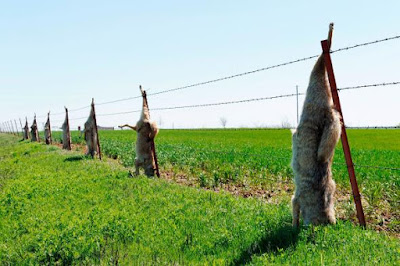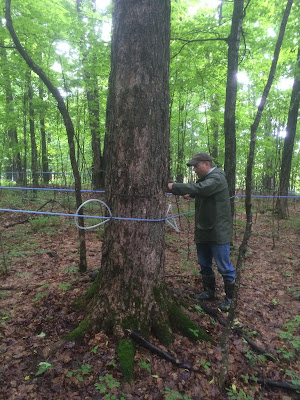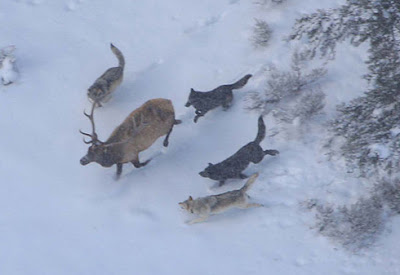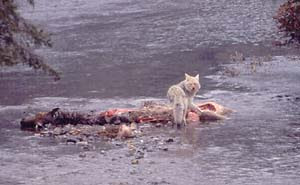After 20 years of wolves occupying Yellowstone National Park, biologist Doug Smith has suggested the answer to a long-asked question: how many elk do Yellowstone wolves eat?
Smith has been studying wolves in the park since they were transplanted there in 1995. Project leader for wolf restoration, he has been with the program since officials carried the first wolf into a holding pen that year.
His photograph of former Secretary of the Interior Bruce Babbitt, the late U.S. Fish and Wildlife Service Director Mollie Beattie, and former park Superintendent Michael Finley hefting a crate full of wolf across the snow is his most famous shot, he told an audience in Jackson last week.
Since then he has been flying over Yellowstone regularly, catching and radio collaring dozens of wolves, mapping pack territories and examining wolf kills to create an unprecedented database. Intensive surveys each winter with a sizable crew, including volunteers, has made the investigation possible. Much of the work was done with private funds.
To answer the question of how many elk an average wolf eats in a year, Smith teased out a figure from seasonal estimates. In early winter, for example, he estimates a wolf will kill and consume 1.4 elk every 30 days.
In late winter that number goes up to 2.2 elk per wolf every 30 days. Over the entire winter season, the average comes out to 1.8 elk per wolf in 30 days.
But that rate doesn’t persist. In summer, wolves turn their attention to deer and even rodents, Smith said.
Over the course of a year, an average wolf will kill — mostly with other pack members — and consume 16 to 22 elk a year, Smith said. “That’s a rough estimate.”
It takes a pack
Elk hunting for wolves usually involves a pack working together, the biologist told his audience. He showed photographs of a pack in hot pursuit of several elk, pointing out the members in the lead. They invariably are younger wolves and females — members of the species that are lighter and faster than large males who typically are the pack leaders.
But the big wolves are often the key to making a kill, Smith said. When they catch up, they latch onto an elk and seal its fate.
Pack sizes correlate to how big the dinner table is, Smith said, and how many wolves can be seated at it. A deer, for example, is large enough to feed a pack of four to six wolves. A dead elk will provide a setting for nine to 10 wolves — typical for pack sizes in Yellowstone.
A dead moose will serve a pack of 15 wolves or more, Smith said. Bison, likewise, would sustain a larger pack.
But large prey like bison are usually successfully hunted only by packs that have at least two big males. Wolves do not hunt bison in Yellowstone as frequently as one might think.
“They don’t kill them in proportion to their availability,” Smith said. He noted the danger a large bison poses to wolves; “Why get your head bashed in?” he asked.
Large prey like Bison and Moose require large packs of Wolves
to engage in the attack
A large wolf can hold up to about 20 pounds of meat in its stomach at a time, Smith said. But after 20 years of chasing wolves and measuring them with a scale, top weight for a big male was 148 pounds — with nothing in its stomach.
Yellowstone says there were at least 98 wolves in 10 packs living primarily in Yellowstone in January 2016. At that time there were some 528 wolves within the Greater Yellowstone Ecosystem, the park said.
Using Smith’s figures, wolves residing primarily in Yellowstone kill between 1,568 and 2,156 elk annually. In the Greater Yellowstone region, wolves take 8,448 to 11,616 elk per year, Smith’s figures indicate.
In Wyoming, humans reported killing 25,852 elk in 2016, according to the Wyoming Game and Fish Department.
Smith also made a counterintuitive observation regarding the relationship of grizzly bears and wolves who fight over a carcass, including winter-killed bison. Grizzlies are frequently able to take over a dead animal, even one initially claimed or killed by a pack of wolves.
That won’t necessarily send wolves off to kill a different animal, Smith said. Instead, they lurk on the fringes, waiting for a chance to steal in and grab a meal. “It actually decreases kill rates,” he said.
Grizzlies taking over a Wolf-killed Elk
Montana’s initial wolf hunting seasons affected Yellowstone wolf packs because the state did not institute adequate hunting areas to limit the killing of members of a particular pack. As a result, some packs were significantly disrupted.
In contrast, Wyoming’s wolf seasons, when they were in effect, included zones in which a limited number of wolves could be killed. That spread the impact among different packs, Smith said.
Since wolves were introduced as an experimental population in Yellowstone, they were removed from the umbrella of federal protection and hunting was allowed in neighboring states outside the park. But Wyoming’s wolf plan was challenged in court and hunting stopped in the Equality State.
Ravens and Magpies enjoy a meal every time Wolves kill an Elk
A federal appeals court recently ruled that Wyoming’s wolf plan provides adequate protection for the species, setting in motion the process of returning control to the state. Hunting could soon follow again.
Smith said the Wyoming Game and Fish Department has a good handle on the hunting scheme. “They did it fine last time,” he said.
But the state must be cautious because it manages for a wolf population very close to the minimum required when the federal government first relinquished authority. There must be 10 packs and 10 breeding pairs outside Yellowstone National Park, plus a buffer. Maintaining a buffer gives the state flexibility should a wolf or pack cause unacceptable damage to livestock, for example, and require killing.
While Gray Wolves will chase and kill Coyotes and
have lowered their pre-1995 Yellowstone population,
remaining Coyotes are able to grab some important
calories when Wolves have their full and nap post
Elk kill
Because Wyoming would like to keep numbers down, “They are going to have to watch and be very careful,” not to go below the agreed-to minimum, Smith said. If that happened it could result in a re-listing under the Endangered Species Act and protection for wolves outside Yellowstone, Grand Teton National Park and the National Elk Refuge.
-------------------------------------------------
Why Are Yellowstone's Elk Disappearing?
Biologists struggle to untangle the ecological web surrounding a mysterious population decline in the national park.
Wildlife biologist Shannon Barber-Meyer, then at the University of Minnesota, followed 151 elk calves in Yellowstone for three years. Almost 70 percent of the calves died before their first birthdays, and Barber-Meyer’s team determined that wolves killed only 15 percent of them.
60 percent of these tagged calves killed by bears (more than half of them by grizzlies). That was three times as much bear predation as was found two decades earlier. Realizing the role of bears revealed a much bigger and messier picture than Middleton had anticipated.
The impact of grizzlies was growing, but their numbers weren’t rising enough to explain the number of calf kills, so Middleton turned to Jennifer Fortin, then a zoology Ph.D. student researching bear nutrition at Washington State University. By conducting long-term monitoring of grizzly bears in and around Yellowstone, she found that grizzlies had historically fed heavily on cutthroat trout they slapped out of the rivers. But in the 1980s, sport fishermen illegally released lake trout into Yellowstone Lake. The enormous invasive trout preyed on the native trout and competed with them for resources. And because the invasive trout spawn in deeper water than their native counterparts, they remain out of grizzlies’ reach. Fortin’s data showed that when fish were scarce, bears stalked the next easiest targets: elk calves.
But predation, even with bears included, didn’t explain elk’s low pregnancy rates. A changing climate, on the other hand, did. Severe droughts since 2000, possibly correlated with climate change, reduced grass production in the areas of the park where elk migrate in the summer. Elk were forced to consume immense quantities of nutrient-poor fodder to try and meet their caloric needs, but most females were still undernourished and therefore unable to conceive.
After spending five years trying to find the one thing that could explain the declining elk populations, Middleton has concluded that there isn’t one — there are many: Trout fishermen, bears, wolves, fish, climate change and factors yet unfound collectively shoulder the weight of that loss. “Changes in the system were perceived as a consequence of wolves,” he explains, but these reintroduced predators actually have a relatively small impact — one that is far outsized by the hoopla surrounding them. The elk population in Yellowstone is at the mercy of a much larger, human-altered ecosystem.
-------------------------------------------------------------
Elk numbers stabilizing in northern Yellowstone
TUESDAY, JAN. 24, 2017
More than 5,300 elk were counted earlier this month in Yellowstone’s northern range and areas outside the park near Gardiner, Montana. The elk numbers were released Monday as part of the Northern Yellowstone Wildlife Working Group elk survey.
They show a 9 percent increase in the area’s elk population from 2016 and mark the third consecutive year the count has surpassed 4,800.
Biologists say it appears elk numbers have rebounded from a significant decline that started in the mid-1990s






































